Three steps are required to define a sampling frame by ZIP Code.
First, define the ZIP Code area.
Second, create a Coverage Report to review the coverage and incidence for the Area Code/Exchange combinations serving that ZIP Code area.
Third, apply a cutoff based on the coverage and incidence for the project.
-- or --
On the Define Frame menu, point to Define Geographic, then to Zip Code, then click Define Zip Code Area.
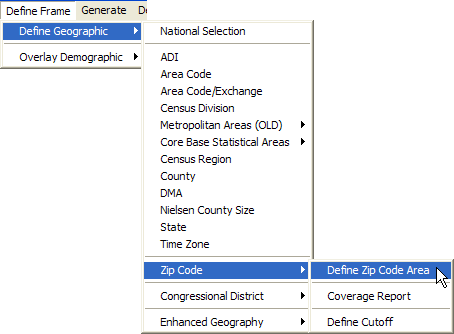
A ZIP Code dialog box opens.
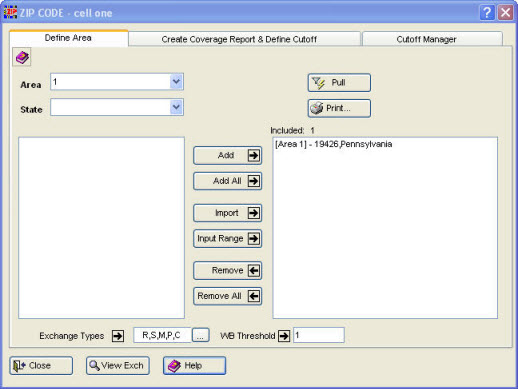
The Define
Area tab is selected. The cell
name is displayed in the title bar. Add
![]() , Add All
, Add All ![]() , Import
, Import ![]() , Input Range
, Input Range ![]() ,
Remove
,
Remove ![]() , and Remove All
, and Remove All ![]() are provided for
convenience.
are provided for
convenience.
To select a ZIP Code and move it into the Included box
 .
. to retrieve
the corresponding exchanges.
to retrieve
the corresponding exchanges.
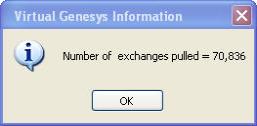
(Click OK ![]() .)
.)
 to open a
Geographic Definition Report for printing.
to open a
Geographic Definition Report for printing.
To define ZIP Code Areas by providing a range of ZIP Codes
 . An Input
Zip Codes dialog box opens.
. An Input
Zip Codes dialog box opens.
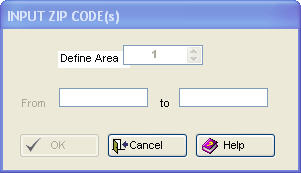
To define the ZIP Code Area by importing a text file containing a list of ZIP Codes
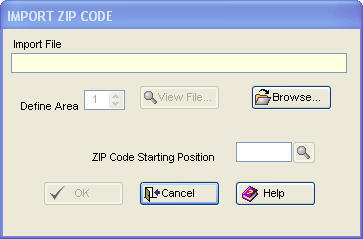
 to locate the import file.
to locate the import file.
From the ZIP CODE dialog box, click the Create Coverage Report & Define Cutoff tab.

In the Virtual
Genesys - ZIP Code Reports group box,
the options for Coverage Report and Display
Exchanges to be Sampled only are both
selected by default. Reports detailing either the Percent of ZIP Code Compromising the Frame or the Percent
of ZIP Code Included in Frame can also
be selected. The coverage report can include only those exchanges that
are to be sampled. Select the Report Format from the list; PDF, XLS, or
HTM. Click Run ![]() to create and view the ZIP
Code Reports. Click Close
to create and view the ZIP
Code Reports. Click Close ![]() ,
or click View
Exch
,
or click View
Exch ![]() for a View Exchanges dialog box.
for a View Exchanges dialog box.
After reviewing the generated report, a cutoff must be defined. The cutoff can be applied on the Create Coverage Report & Define Cutoff tab, or by using the Cutoff Manager.
A message displays the original number of exchanges, the number excluded, and the number retained.
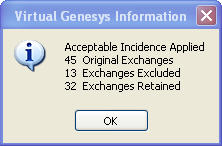
(Click
OK ![]() .)
.)
Clicking Reset ![]() will remove any applied cutoffs and will restore any
excluded exchanges.
will remove any applied cutoffs and will restore any
excluded exchanges.

Click Yes ![]() .
.
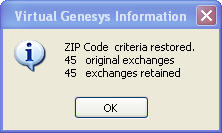
(Click
OK ![]() .)
.)
After running the coverage report and applying
the cutoff, the exchanges pulled can be viewed by clicking View
Exch ![]() . A View Exchanges dialog box opens.
. A View Exchanges dialog box opens.
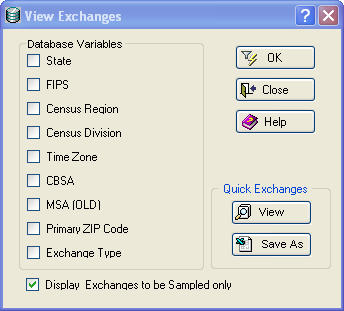
From the Database
Variables group box, select the variables to be included in the
Exchange Report. If
the report should include only those exchanges to be sampled, then click
the Display
Exchanges to be Sampled only check
box. In the
Quick Exchanges group box, View ![]() and Save
As
and Save
As ![]() allow the data
to be viewed or saved. Click OK
allow the data
to be viewed or saved. Click OK
 . The resulting
Exchange Report can be printed, or saved as an Excel spreadsheet
or ASCII file.
. The resulting
Exchange Report can be printed, or saved as an Excel spreadsheet
or ASCII file.
To apply a cutoff using the Cutoff Manager, move either the Incidence or Coverage slider. Moving one affects the other.
For numeric percentage information on where the sliders
are located and how this affects the sampling frame, see the Incidence
and Coverage display ![]() in the upper right corner.
in the upper right corner.
Click Apply ![]() to select a cutoff. Click Reset
to select a cutoff. Click Reset  to remove any previously applied cutoff. Click History
to remove any previously applied cutoff. Click History ![]() to display any cutoff that is currently being applied.
Click Details
to display any cutoff that is currently being applied.
Click Details ![]() provides a report on incidence,
coverage, and the ZIP Codes included and excluded from the sampling frame.
Click View Map
provides a report on incidence,
coverage, and the ZIP Codes included and excluded from the sampling frame.
Click View Map ![]() to see a ZIP Code map.
to see a ZIP Code map.
A Display ZIP Code Coverage Map opens.
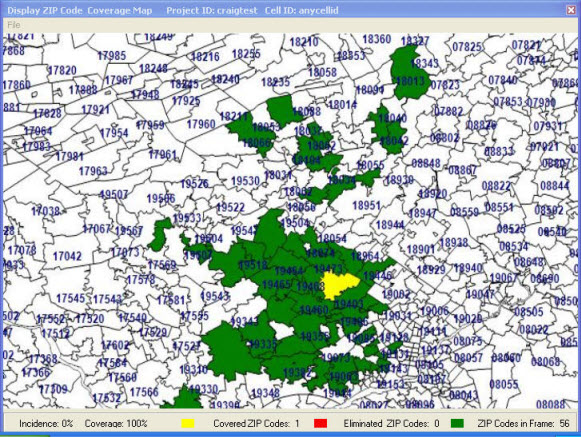
The map displays the ZIP Code sampling frame at the current cutoff level. The map also displays the overall expected incidence and coverage.
GREEN indicates the ZIP Codes served by the exchanges in the sampling frame.
YELLOW indicates the ZIP Codes covered by the exchanges remaining in the sampling frame.
RED indicates the ZIP Codes now eliminated at the selected incidence cutoff that were originally in the sampling frame.
When using the Import or Input Range ZIP Code functions, a message may say some of the ZIP codes were not added. This occurs when the ZIP codes requested are not defined in the Genesys database.
When ZIP Codes are not included in the Genesys database, they don't have residences associated with them. Such ZIP Codes include PO Box-only ZIP codes or business-only ZIP codes. There are some ZIP Codes that, while they are included in the database, can't be viewed within Genesys. This occurs when the ZIP Code in question doesn't have enough listed households for it to be assigned as one of the primary six ZIP Codes for an exchange.